
Kiwa hirsuta is a crustacean discovered in 2005 in the South Pacific Ocean. This decapod, which is approximately 15 cm (5.9 in) long, is notable for the quantity of silky blond setae covering its pereiopods. Its discoverers dubbed it the "yeti lobster" or "yeti crab".

Kiwa is a genus of marine decapods living at deep-sea hydrothermal vents and cold seeps. The animals are commonly referred to as "yeti lobsters" or "yeti crabs”, after the legendary yeti, because of their "hairy" or bristly appearance. The genus is placed in its own family, Kiwaidae, in the superfamily Chirostyloidea. The genus Kiwa is named after the god of shellfish in Polynesian mythology.

Tonguefishes are flatfish in the family Cynoglossidae. They are distinguished by the presence of a long hook on the snout overhanging the mouth, and the absence of pectoral fins. Their eyes are both on the left side of their bodies, which also lack a pelvic fin. This family has three genera with a total of more than 140 species. The largest reaches a length of 66 cm (26 in), though most species only reach half that size or less. They are found in tropical and subtropical oceans, mainly in shallow waters and estuaries, though some species are found in deep sea floors, and even a few in rivers.

The Bythograeidae are a small family of blind crabs which live around hydrothermal vents. The family contains 16 species in six genera. Their relationships to other crabs are unclear. They are believed to eat bacteria and other vent organisms. Bythograeidae are a monophyletic, sister taxon of the superfamily Xanthoidea which split to inhabit hydrothermal vents around the Eocene.
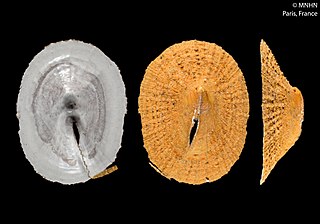
Pseudorimula is a genus of sea snails, marine gastropod molluscs in the family Lepetodrilidae.

Careproctus is a genus of snailfishes found in benthic and benthopelagic habitats in the Atlantic, Pacific, Arctic and Southern Oceans. Whether they truly are absent from the Indian Ocean is unknown and might be an artifact of limited sampling. They range from shallow coastal seas in the far north of their range to the abyssal zone, at depths of 6 to 5,459 m (20–17,910 ft). In the Northern Hemisphere they mostly live shallower than Paraliparis, but this pattern is reversed in the Southern Hemisphere. Although almost entirely restricted to very cold waters, a single species, C. hyaleius, lives at hydrothermal vents.

Gandalfus yunohana is a species of blind crab in the family Bythograeidae found on hydrothermal vents on the eastern edge of the Philippine Sea Plate south of Japan. Because no light penetrates to such depths, the eyes of G. yunohana are immobile and unpigmented.
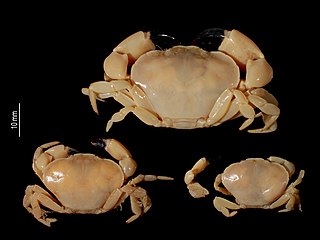
Euryxanthops is a genus of crabs in the family Xanthidae. It was originally established in 1983 by Garth & Kim to contain three species of deep-water crabs from Japan and the Philippines - Euryxanthops dorsiconvexus, Euryxanthops flexidentatus and Euryxanthops orientalis. Since then, several more species of this genus have been identified and described, and Euryxanthops currently contains:
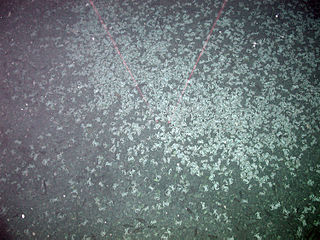
Cyanagraea praedator is a species of crab that lives on hydrothermal vents, and the only species in the genus Cyanagraea.

Vulcanoctopus hydrothermalis, also known as the vent octopus, is a small benthic octopus endemic to hydrothermal vents. It is the only known species of the genus Vulcanoctopus. This vent octopus is endemic to the hydrothermal vent habitat that is located in the East Pacific Rise.
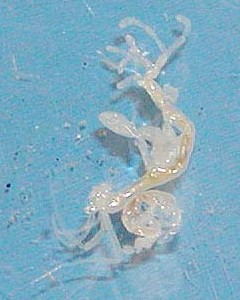
Caprella bathytatos is a species of skeleton shrimp in the genus Caprella. It was described in 1998 by Joel W. Martin and Gary Pettit, who discovered it living on the mouthparts of the crab Macroregonia macrochira near hydrothermal vents in British Columbia.

Kiwa tyleri, the Hoff crab, is a species of deep-sea squat lobster in the family Kiwaidae, which lives on hydrothermal vents near Antarctica. The crustacean was given its English nickname in 2010 by UK deep-sea scientists aboard the RRS James Cook, owing to resemblance between its dense covering of setae on the ventral surface of the exoskeleton and the hairy chest of the actor David Hasselhoff. The 2010 expedition to explore hydrothermal vents on the East Scotia Ridge was the second of three expeditions to the Southern Ocean by the UK led research consortium, ChEsSo.
Colin McLay (1942-2022) was a New Zealand marine biologist and carcinologist. Educated at the University of Otago and the University of British Columbia, he served as an Associate Professor of Marine Biology at the University of Canterbury. He discovered several species of crab, including Desmodromia tranterae, Euryxanthops chiltoni, Gandalfus puia, and Hirsutodynomene vespertilio.

Gandalfus puia is the only known New Zealand species of crab in the family Bythograeidae, commonly known as the blind vent crabs. Like other blind vent crabs, it only lives in hydrothermal vent waters. This species was first described in 2007 after specimens were collected from the undersea volcanic ridge near the Kermadec Islands.
Biospeedotrema parajolliveti is a species of trematodes inhabiting hydrothermal vent fishes in the south eastern Pacific Ocean. It can be distinguished from its family by its symmetrical testicular configuration; its uterus passing between the testes.
Luckia is a genus of amphipod crustaceans in the family Pontogeneiidae, with the sole species Luckia striki. It is found in hydrothermal vents in the Atlantic Ocean.
Paulasterias mcclaini is a species of starfish in the family Paulasteriidae. It is found in deep water at hydrothermal vents.
Paulasterias tyleri is a species of starfish in the family Paulasteriidae. It is found in deep water at hydrothermal vents in the Antarctic. It is the type species of the newly erected genus Paulasterias, the only other member of the genus being Paulasterias mcclaini.
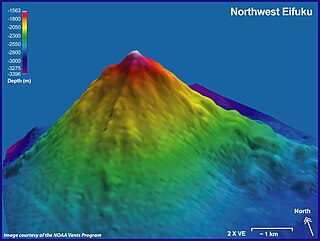
Eifuku and NW Eifuku (北西永福) are two seamounts in the Pacific Ocean. The better known one is NW Eifuku, where an unusual hydrothermal vent called "Champagne" produced droplets of liquid CO
2. Both seamounts are located in the Northern Marianas and are volcanoes, part of the Izu-Bonin-Mariana Arc. NW Eifuku rises to 1,535 metres (5,036 ft) depth below sea level and is a 9 kilometres (5.6 mi) wide volcanic cone.
Pyrolycus is a genus of marine ray-finned fishes belonging to the subfamily Lycodinae, the eelpouts, within the family Zoarcidae. The genus was first described in 2002 by Japanese ichthyologists Yoshihiko Machida and Jun Hashimoto. The type species is P. manusanus, which was discovered in the Manus Basin off Papua New Guinea.













